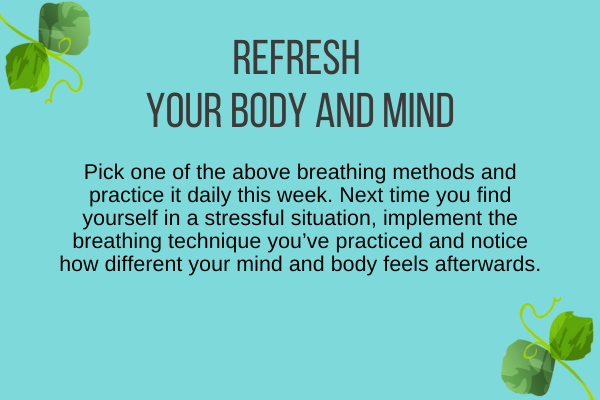In our fast-paced world, knowing how to manage stress is essential for our well-being. While there are many ways to reduce stress, one effective and accessible tool is right under your nose: your breath. Breathwork, the practice of using breathing exercises to calm the body and mind, is a powerful way to manage stress and increase relaxation. So let’s explore some simple and effective breathwork techniques that can help you feel more grounded, centered, and at peace.
Why Breathwork Matters for Stress Relief
Breathing is something we do naturally, but how we breathe can significantly impact our nervous system. Breathwork exercises can lower cortisol levels, reduce muscle tension, and activate the body’s “rest and digest” response, allowing us to handle stress better. With just a few minutes each day, you can use breathwork to shift from a stressed, anxious state to one of calm and relaxation. Here are some techniques you can use anytime, anywhere to manage stress. Try each one and pick one that feels good for you:
Box Breathing (4-4-4-4 Technique)
Box breathing is a simple but effective breathwork technique that can quickly reduce anxiety and stress. To practice box breathing, breathe in through your nose for a count of 4, hold your breath for a count of 4, exhale through your mouth for a count of 4, and then pause for a count of 4 before inhaling again. Repeat for 3-5 minutes. This method helps you regulate your breathing, slows your heart rate, and promotes a sense of calm by giving you a structured rhythm to focus on.
Diaphragmatic Breathing (Belly Breathing):
Diaphragmatic or belly breathing involves breathing deeply from your abdomen rather than your chest, allowing you to take fuller, slower breaths. To practice, place one hand on your chest and the other on your belly. Inhale deeply through your nose, feeling your belly expand as you breathe in. Exhale slowly through your mouth, noticing your belly fall. Practice this for 5 minutes, allowing each breath to be slow and intentional. This technique helps increase oxygen flow, reduces muscle tension, and encourages relaxation by calming the body’s stress response.
Alternate Nostril Breathing (Nadi Shodhana):
Alternate nostril breathing is a traditional yogic technique that balances the body and calms the mind. To practice, sit comfortably, close your right nostril with your thumb, and inhale through your left nostril. Close your left nostril with your ring finger, release your right nostril, and exhale through it. Then, inhale through the right nostril, close it, and exhale through the left. Repeat this cycle for 5-10 minutes. This technique helps reduce anxiety, improve focus, and bring a sense of balance and calm to the mind and body.
4-7-8 Breathing Technique:
Developed by Dr. Andrew Weil, this technique is designed to slow down your breathing and promote relaxation. Begin by inhaling quietly through your nose for a count of 4, hold your breath for a count of 7, and then exhale completely through your mouth for a count of 8. Repeat for four cycles. This exercise helps to lower blood pressure and ease anxiety, making it especially helpful if you’re struggling with stress in the moment or having trouble winding down before bed.
Resonant Breathing (Coherent Breathing):
Resonant breathing, also known as coherent breathing, involves slowing your breath to about 5-6 breaths per minute. To practice, inhale slowly through your nose for a count of 5, and then exhale slowly through your nose for a count of 5. Repeat for 5-10 minutes. This rhythm helps synchronize your heart rate and breath, promoting a state of calmness and relaxation. Resonant breathing has been shown to reduce stress levels, boost mood, and improve resilience to daily stressors.
Sighing Exhale Technique:
When we’re stressed, a long sigh can often feel naturally relieving. The sighing exhale technique uses this concept to promote relaxation. Start by taking a deep inhale through your nose, then let out a long, slow exhale through your mouth, releasing any tension as you do. Repeat several times, allowing your body to relax more with each exhale. This technique helps clear the mind, ease physical tension, and offers immediate relief from stress.

Breathwork is a powerful, free, and accessible tool that can help you manage stress wherever you are.
By practicing these techniques regularly, you’ll not only find it easier to relax in the moment but also build resilience against daily stressors. Whether you have a few minutes during the day or need a longer session to unwind, these breathwork exercises can make a significant difference.
You have the power to calm your mind and reduce stress, one breath at a time!

